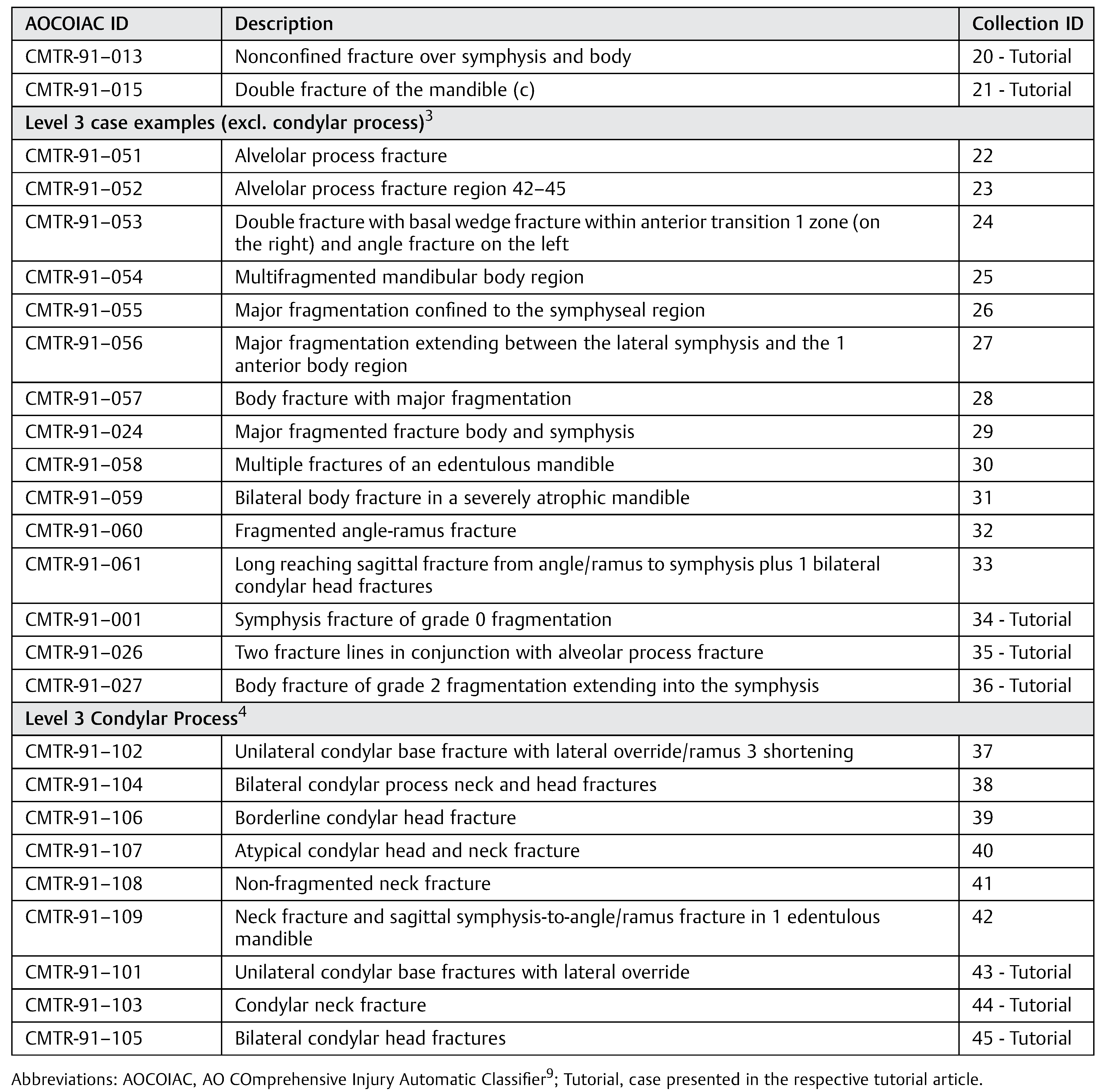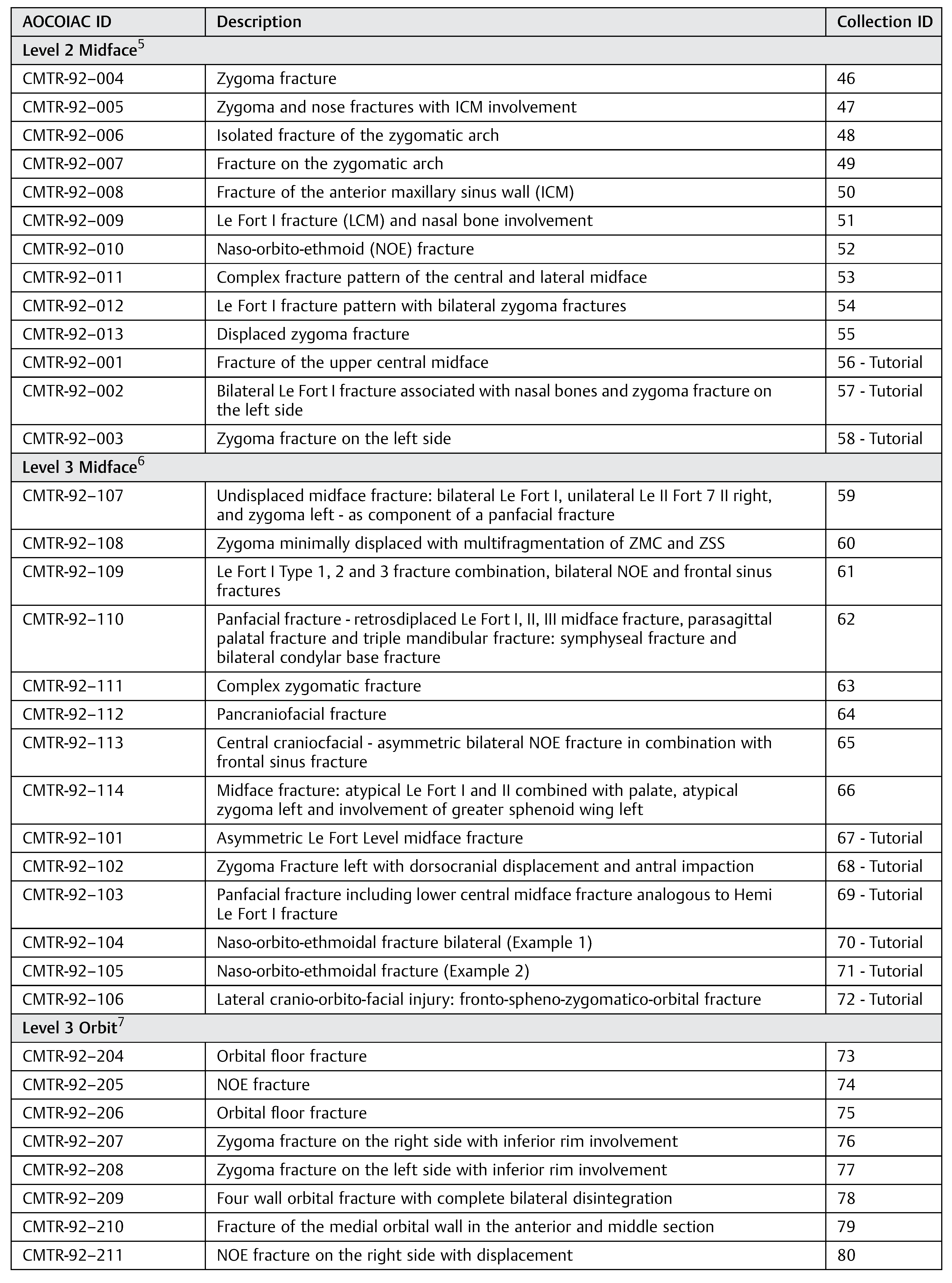The Comprehensive AOCMF Classification System: Fracture Case Collection, Diagnostic Imaging Work Up, AOCOIAC Iconography and Coding
Abstract
:- Level-1 is most elementary and identifies no more than the presence of fractures in 4 separate anatomical units: the mandible (code 91), midface (92), skull base (93) and cranial vault (94).
- Level-2 relates the detailed topographic location of the fractures within defined regions of the mandible, central and lateral midface, and internal orbit. The endocranial surface of the skull base is divided in 9 regions: a central part further subdivided into 3 components (cribriform plate and ethmoido-sphenoidal planum, sellar/parasellar compartment, clivus) adjoined by two lateral parts each encompassing an anterior, middle and posterior component. The regions of the exocranial skull base and the cranial vault are defined according to common anatomical nomenclature into paired and non-paired bones: frontal, parietal, temporal, sphenoid and occipital.
- Level-3 is based on an even more refined topographic assessment and focuses on the morphology – fragmentation, displacement, and bone defects – within the specified subregions, parts and components.
Objective
 |
 |
Access to Additional Electronic Content
Note and Disclaimer
 |
 |
References
- Audigé, L.; Cornelius, C.P.; Di Ieva, A.; et al. The first AO classification system for fractures of the craniomaxillofaxial skeleton: rationale, methodological background, developmental process and objectives. Craniomaxillofac Trauma Reconstr 2014, 7 (Suppl 1), S6–S14. [Google Scholar]
- Cornelius, C.P.; Audigé, L.; Kunz, C.; et al. The comprehensive AOCMF classification system: mandible fractures - level 2 tutorial. Craniomaxillofac Trauma Reconstr 2014, 7 (Suppl 1), S15–S30. [Google Scholar] [CrossRef] [PubMed]
- Cornelius, C.P.; Audigé, L.; Kunz, C.; et al. The comprehensive AOCMF classification system: mandible fractures - level 3 tutorial. Craniomaxillofac Trauma Reconstr 2014, 7 (Suppl 1), S31–S43. [Google Scholar] [CrossRef] [PubMed]
- Neff, A.; Cornelius, C.P.; Rasse, M.; et al. The comprehensive AOCMF classification system: condylar process fractures - level 3 tutorial. Craniomaxillofac Trauma Reconstr 2014, 7 (Suppl 1), S44–S58. [Google Scholar] [CrossRef] [PubMed]
- Kunz, C.; Audigé, L.; Cornelius, C.P.; et al. The comprehensive AOCMF classification system: midface fractures - level 2 tutorial. Craniomaxillofac Trauma Reconstr 2014, 7, S59–S567. [Google Scholar] [CrossRef] [PubMed]
- Cornelius, C.P.; Audigé, L.; Kunz, C.; et al. The comprehensive AOCMF classification system: midface fractures - level 3 tutorial. Craniomaxillofac Trauma Reconstr 2014, 7 (Suppl 1), S68–S91. [Google Scholar] [CrossRef] [PubMed]
- Kunz, C.; Audigé, L.; Cornelius, C.P.; et al. The comprehensive AOCMF classification system: orbital fractures - level 3 tutorial. Craniomaxillofac Trauma Reconstr 2014, 7 (Suppl 1), S92–S102. [Google Scholar] [CrossRef] [PubMed]
- Di Ieva, A.; Audigé, L.; Kellman, R.M.; et al. The comprehensive AOCMF classification system: skull base and cranial vault fractures - level 2 and 3 tutorial. Craniomaxillofac Trauma Reconstr 2014, 7 (Suppl 1), S103–S113. [Google Scholar] [CrossRef]
- Audigé, L.; Cornelius, C.P.; Buitrago-Téllez, C.; et al. The comprehensive AOCMF classification system: classification and documentation within AOCOIAC software. Craniomaxillofac Trauma Reconstr 2014, 7 (Suppl 1), S114–S122. [Google Scholar] [CrossRef] [PubMed]
© 2014 by the author. The Author(s) 2014.
Share and Cite
Cornelius, C.-P.; Kunz, C.; Neff, A.; Kellman, R.M.; Prein, J.; Audigé, L. The Comprehensive AOCMF Classification System: Fracture Case Collection, Diagnostic Imaging Work Up, AOCOIAC Iconography and Coding. Craniomaxillofac. Trauma Reconstr. 2014, 7, 131-135. https://doi.org/10.1055/s-0034-1393722
Cornelius C-P, Kunz C, Neff A, Kellman RM, Prein J, Audigé L. The Comprehensive AOCMF Classification System: Fracture Case Collection, Diagnostic Imaging Work Up, AOCOIAC Iconography and Coding. Craniomaxillofacial Trauma & Reconstruction. 2014; 7(s1):131-135. https://doi.org/10.1055/s-0034-1393722
Chicago/Turabian StyleCornelius, Carl-Peter, Christoph Kunz, Andreas Neff, Robert M. Kellman, Joachim Prein, and Laurent Audigé. 2014. "The Comprehensive AOCMF Classification System: Fracture Case Collection, Diagnostic Imaging Work Up, AOCOIAC Iconography and Coding" Craniomaxillofacial Trauma & Reconstruction 7, no. s1: 131-135. https://doi.org/10.1055/s-0034-1393722
APA StyleCornelius, C.-P., Kunz, C., Neff, A., Kellman, R. M., Prein, J., & Audigé, L. (2014). The Comprehensive AOCMF Classification System: Fracture Case Collection, Diagnostic Imaging Work Up, AOCOIAC Iconography and Coding. Craniomaxillofacial Trauma & Reconstruction, 7(s1), 131-135. https://doi.org/10.1055/s-0034-1393722



